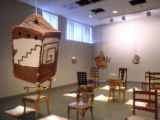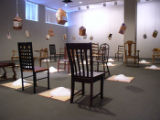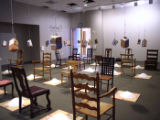Filters: Date: "2006" Collection: "ir_uspace"
| Creator | Title | Description | Subject | Date | ||
|---|---|---|---|---|---|---|
| 26 |
 |
Couldwell, William T. | Combined transmastoid retro- and infralabyrinthine transjugular transcondylar transtubercular high cervical approach for resection of glomus jugulare tumors | COMPLEX TUMORS OF the glomus jugulare present a surgical challenge because of their difficult location, extreme vascularity, and involvement with multiple cranial nerves. Modern microneurosurgical and cranial base techniques have enabled safe total removal of these complicated tumors. We describe a ... | Cranial base approach; Surgical approach; Glomus jugulare tumor; Jugular foramen exposure; Microsurgical anatomy | 2006 |
| 27 |
 |
Vardeny, Zeev Valentine | Comment on "Large optical nonlinearity of semiconducting single-walled carbon nanotubes under resonant excitations" | In a recent Letter Maeda et al. studied the optical nonlinearities of single-walled carbon nanotubes (SWNT) films using both ??Z-scan?? and ??pump and probe?? (PP) techniques with ~100 fs time resolution [1]. They found that SWNTs have a large resonant third-order nonlinear optical susceptibili... | SWNT; Coherent artifact | 2006 |
| 28 |
 |
Vardeny, Zeev Valentine; Ehrenfreund, Eitan A. | Comment on "Yield of singlet excitons in organic light-emitting devices: a double modulation photoluminescence-detected magnetic resonance study" | In a recent Letter [1] Lee et al. studied the spin 1/2 photoluminescence-detected magnetic resonance (PLDMR) of a soluble derivative of poly-phenylene vinylene [MEH-PPV] using a double modulation scheme, where both the laser excitation intensity and the microwave power were modulated at ?ex and ?... | Singlet excitons; PLDMR; Poly-phenylene vinylene; MEH-PPV; Quenching; Spin dependent recombination; OLED | 2006 |
| 29 |
 |
Couldwell, William T. | Comment on Nugent, G. R.: Targeting the ventral lateral nucleus of the thalamus: a stereotactic vignette | Dr. Nugent provides a fascinating personal account of his early experience with stereotactic surgery for movement disorders. I was especially pleased to read the positive comments regarding the personal interactions with and innovations of Irving Cooper, a neurosurgeon who was derided by his peers b... | Stereotactic surgery; Stereotaxis | 2006 |
| 30 |
 |
Couldwell, William T. | Comment on Wong, H. T., et al.: Comparative impact of video consultation on emergency neurosurgical referrals | The Author's explored the facility and accuracy of telephone, teleradiology, or video consultation between a large general hospital and their tertiary neurosurgical center. Although there was increased diagnostic accuracy with video consultation or teleradiology, they note that consultation via vid... | Teleradiology; Video consultation; Neurosurgical referrals | 2006 |
| 31 |
 |
Jewell, Paul | Controls of tufa development in Pleistocene Lake Bonneville, Utah | Prominent tufa localities along the Provo level (∼14,000 14C yr B.P.) shoreline in Pleistocene Lake Bonneville have been characterized in detail. Three types of tufa are recognized: capping tufa, beachrock, and capping tufa over beachrock. Capping tufa and beachrock are end members of a continuum ... | Tufa; Pleistocene; Pluvial lakes | 2006 |
| 32 |
 |
Olivera, Baldomero M. | Conus peptides: biodiversity-based discovery and exogenomics | The venoms of the ~700 species of predatory cone snails (genus Conus) are being systematically characterized. Each Conus species contains 100-200 small, highly structured venom peptides (colloquially known as conotoxins), which are synthesized and secreted in a venom duct (for overviews, see Refs. ... | Conotoxins; Conus peptides; Exogenomics | 2006 |
| 33 |
 |
Carrier, David R. | Coupled evolution of breathing and locomotion as a game of leapfrog | Because the increase in metabolic rate related to locomotor activity places demands on the cardiorespiratory apparatus, it is not surprising that the evolution of breathing and of locomotion are coupled. As the respiratory faculty becomes more refined, increasingly aerobic life strategies can be exp... | Evolution; Coupled evolution; Breathing; Locomotion; Cardiorespiratory apparatus | 2006 |
| 34 |
 |
Snapp, Brian | Curing, detail view | Form: installation; Medium: mixed media; Dimensions: variable | Painting | 2006 |
| 35 |
 |
Snapp, Brian | Curing, detail view | Form: installation; Medium: mixed media; Dimensions: variable | Painting | 2006 |
| 36 |
 |
Snapp, Brian | Curing, sitting view | Form: installation; Medium: mixed media; Dimensions: variable | Painting | 2006 |
| 37 |
 |
Snapp, Brian | Curing, sitting view | Form: installation; Medium: mixed media; Dimensions: variable | Painting | 2006 |
| 38 |
 |
Snapp, Brian | Curing, view from the entrance | Form: installation; Medium: mixed media; Dimensions:variable | Painting | 2006 |
| 39 |
 |
Snapp, Brian | Curing, view from the entrance | Form: installation; Medium: mixed media; Dimensions:variable | Painting | 2006 |
| 40 |
 |
Snapp, Brian | Curing, view from the southeast corner | Form: installation; Medium: mixed media; Dimensions: variable | Painting | 2006 |
| 41 |
 |
Snapp, Brian | Curing, view from the southeast corner | Form: installation; Medium: mixed media; Dimensions: variable | Painting | 2006 |
| 42 |
 |
Chuaqui, Miguel Basim | Desde el Límite | In Desde el Límite (From the Edge) I was inspired by the experience of my granduncle, Benedicto Chuaqui as presented in his book "Memorias de un Emigrante" (Memoirs of an Immigrant), who immigrated to Chile from Syria in the early 1900s. In the work there are disguised references to American musica... | From the Edge; Benedicto Chuaqui; Chilean music | 2006 |
| 43 |
 |
Mathews, V. John | Design of low-delay nonuniform pseudo QMF banks | ABSTRACT This paper presents a method for designing low-delay nonuniform pseudo QMF banks. The method is motivated by the work of Li, Nguyen and Tantaratana, in which the nonuniform filter bank is realized by combining an appropriate number of adjacent subbands of a uniform pseudo QMF filter ban... | 2006 | |
| 44 |
 |
Owen, William E.; Rockwood, Alan L.; Roberts, William L.; Meikle, A. Wayne | Development and performance evaluation of a tandem mass spectrometry assay for 4 adrenal steroids | Congenital adrenal hyperplasia is a group of autosomal recessive disorders caused by a deficiency of 1 of 4 enzymes required for the synthesis of glucocorticoids, mineralocorticoids, and sex hormones. Analysis of 11-deoxycortisol (11DC), 17-hydroxyprogesterone (17OHP), 17-hydroxypregnenolone (17O... | Congenital adrenal hyperplasia; Adrenal steroids; Tandem mass spectrometry assay | 2006 |
| 45 |
 |
Couldwell, William T.; Jensen, Randy L.; Jensen, Elizabeth M. | Development of contrast enhancement after long-term observation of a dysembryoplastic neuroepithelial tumor | Dysembryoplastic neuroepithelial tumors (DNET) are usually benign lesions that arise in cortical regions and are discovered after new onset of seizure. These lesions have many different imaging characteristics. We report a patient with a presumed low-grade medial temporal lobe lesion that was follow... | Brain tumor; Dysembryoplastic neuroepithelial tumors; DNET; Imaging; Seizures | 2006 |
| 46 |
 |
Dailey, Andrew T. | Diagnosis and treatment of craniocervical dislocation in a series of 17 consecutive survivors during an 8-year period | Object. Craniocervical dissociation (CCD) is a highly unstable and usually fatal injury resulting from osseoligamentous disruption between the occiput and C-2. The purpose of this study was to elucidate systematic factors associated with delays in diagnosing and treating this life-threatening condit... | Spinal cord injury; Craniocervical dislocation; Atlantooccipital joint; Atlantoaxial joint; Tetraplegia; CCJ; CCD | 2006 |
| 47 |
 |
Yu, Zhou | Different path to homeownership: The case of Taiwanese immigrants in Los Angeles | Taiwanese immigrants in Los Angeles stand in contrast to the welldocumented homeownership deficit among immigrants. Despite the tremendous growth in Taiwanese immigrants during the 1980s, Taiwanese homeownership rate not only was among the highest of all ethnic groups in 1990,... | Taiwanese immigrants; Homeownership; Los Angeles; adaptation | 2006 |
| 48 |
 |
Horch, Kenneth W. | Differential activation of nerve fibers with magnetic stimulation in humans | Earlier observations in our lab had indicated that large, time-varying magnetic fields could elicit action potentials that travel in only one direction in at least some of the myelinated axons in peripheral nerves. The objective of this study was to collect quantitative evidence for magnetically in... | Magnetic stimulation; Peripheral nerve; Electromyographic potential; Somatosensory potential | 2006 |
| 49 |
 |
Gesteland, Raymond F.; Atkins, John F.; Baranov, Pavel V. | Diverse bacterial genomes encode an operon of two genes, one of which is an unusual class-I release factor that potentially recognizes atypical mRNA signals other than normal stop codons | ABSTRACT: Background: While all codons that specify amino acids are universally recognized by tRNA molecules, codons signaling termination of translation are recognized by proteins known as class-I release factors (RF). In most eukaryotes and archaea a single RF accomplishes termination at all three... | Class-I release factors; RF1; RF2; Bacterial genomes | 2006 |
| 50 |
 |
Adler, Frederick R. | Do rhinoviruses follow the neutral theory? The role of cross-immunity in maintaining the diversity of the common cold | Over 100 serotypes of rhinoviruses, one of the primary causes of the common cold, co-circulate in the human population. This high diversity makes it effectively impossible to develop a vaccine, even for those at risk of complications due to asthma or cystic fibrosis. | Serotypes; mutation rate; immunodominance | 2006 |
